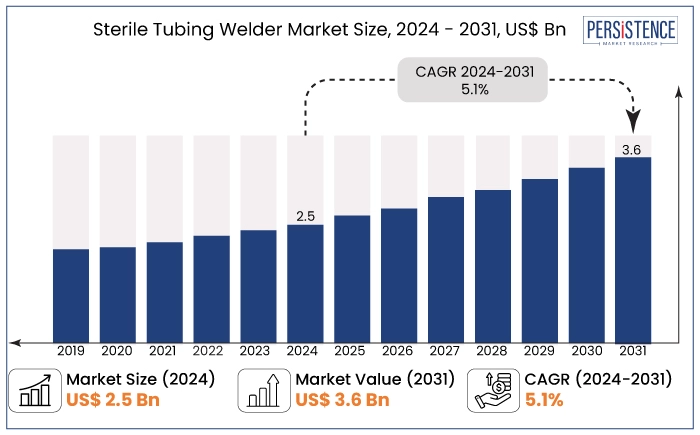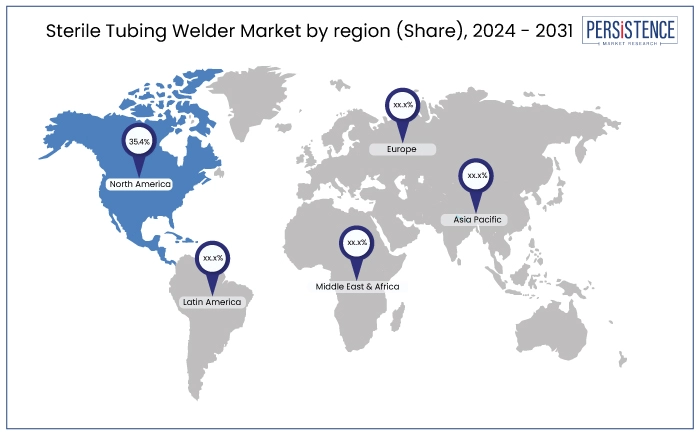ID: PMRREP34924| 177 Pages | 13 Nov 2024 | Format: PDF, Excel, PPT* | Healthcare

The sterile tubing welder market is projected to witness a CAGR of 5.1% during the forecast period from 2024 to 2031. It is anticipated to increase from US$ 2.5 Bn recorded in 2024 to a decent US$ 3.6 Bn by 2031. Rising prevalence of chronic diseases and significant investments in the biopharmaceutical sector are set to fuel demand.
As per the Institute for Health Metrics and Evaluation, anemia was anticipated to affect around 1.92 billion people worldwide in 2021, or around one-fourth of the world's population. Increasing prevalence of anemia is expected to create an urgent need for blood transfusion, thereby boosting sterile tubing welder demand.
Benefits from research and development investments of multinational companies and the need for unique technologies for infection control further boost the need for automatic sterile tubing welders. Government initiatives across various countries also play a key role in creating awareness and augmenting the industry. For instance, the National Center for Disease Control (NCDC) conducts training programs for healthcare workers to improve their knowledge and skills in infection prevention.

Key Highlights of the Market
|
Market Attributes |
Key Insights |
|
Sterile Tubing Welder Market Size (2024E) |
US$ 2.5 Bn |
|
Projected Market Value (2031F) |
US$ 3.6 Bn |
|
Global Market Growth Rate (CAGR 2024 to 2031) |
5.1% |
|
Historical Market Growth Rate (CAGR 2019 to 2023) |
4.8% |
In 2024, North America is set to lead the market, capturing around 35.4% of the value share. This growth is anticipated to be driven by the increasing prevalence of chronic diseases, advances in technology, and the rising need for sterile environments to prevent contamination.
Significant investments in the biopharmaceutical and pharmaceutical sectors further enhance market expansion. The Pharmaceutical Research and Manufacturers of America highlights that the U.S. biopharmaceutical industry was the most research and development-intensive in 2023, investing about US$ 96 Bn worldwide.

Asia Pacific is poised for steady growth with a CAGR of about 5.9% during the forecast period. This surge is anticipated to be fueled by significant investments from multinational companies in research and development activities.
China has emerged as a critical hub, ranking second globally for patent end uses and authorizations in life sciences and biotechnology as of 2018. The country also promotes investments and initiates new programs in life science and healthcare. For example,
Similar initiatives in the country are anticipated to create new growth avenues for market players.
|
Category |
Market Share in 2024 |
|
End Use- Hospitals |
40.5% |
In 2024, the hospitals segment is likely to remain dominant in the global market. It is attributed to the easy availability of a wide array of treatment options as well as the rising number of patients seeking diagnosis and treatment for blood disorders.
Strict infection control protocols in hospitals make sterile tubing welders essential, as these ensure the sterility of key medical devices like IV lines and catheters. With a growing focus on infection prevention, demand for these welders is set to rise. Companies in this field aim to prevent infection by offering several products and modules to hospitals. For example,
|
Category |
Market Share in 2024 |
|
Mode- Automatic |
80.3% |
Based on mode, the automatic segment is likely to dominate the market. These sterile tubing welders stand out due to their high efficiency and productivity, thereby significantly outpacing traditional manual welding methods.
By automating the welding process, these machines minimize the need for manual labor, allowing for faster production and higher throughput. As hospitals continue to seek ways to boost productivity and cut costs, the need for automatic welders is set to rise. This trend not only reflects technological innovations but also a broader commitment to enhancing operational efficiency across industries.
The global sterile tubing welder market is anticipated to showcase decent growth in the forecast period amid increasing demand for sterile and contamination-free environments in the pharmaceutical and medical sectors. Manufacturers are set to focus on enhancing product safety and efficacy as well as innovations in welding technology. This is projected to fuel developments, such as unique laser and thermal welding techniques, which are boosting demand.
Latest trends indicate a shift toward automation and smart technologies, enabling precise welding processes and minimizing human error. The rise in biopharmaceutical production and growing emphasis on personalized medicine are further fueling the need for efficient sterile connection systems.
Sustainability is also gaining traction, with companies seeking eco-friendly materials and processes. The market is poised for expansion as it adapts to the changing industry requirements and technological developments.
The sterile tubing welder industry exhibited steady growth at a CAGR of 4.8% from 2019 to 2023. This growth trajectory reflects the increasing demand for sterile connections in the biopharmaceutical and medical sectors.
As of 2024, there are around 3,000 biopharmaceutical companies operating in the U.S. alone. As these sectors broaden, demand for cutting-edge sterile tubing welders is anticipated to surge.
The market is projected to accelerate, achieving a CAGR of 5.1% from 2024 to 2031. This growth is likely to be pushed by advancements in welding technologies and the rising emphasis on safety and efficiency in manufacturing processes.
As the industry evolves, the integration of automation and smart technologies will further enhance productivity. These trends and factors are expected to boost the sterile tubing welder market for further expansion in the coming years.
Increasing Demand for Biopharmaceuticals to Boost Growth
The rise in biopharmaceutical production is a key growth driver for the sterile tube welder industry. This high production rate is fueled by ongoing investments and innovative offerings by leading companies.
Companies like Watson-Marlow Fluid Technology Group, based in the U.K., recently launched their BioPure single-use sterile tubing welders to cater to the rising demand. These welders enhance efficiency and minimize contamination risks in biopharmaceutical manufacturing.
A few studies reveal a global biopharmaceutical research and development investment of US$ 276 Bn across 4,191 companies in 2021, containing both publicly traded and privately owned companies. This underscores the need for unique sterile connection technologies, further bolstering market growth.
High Focus on Quality Control to Augment Demand
Stringent regulatory requirements regarding product safety and sterility are propelling sales of sterile tube welders for pharmaceutical tubes. The U.S. Food and Drug Administration (FDA) has emphasized the need for rigorous quality control in the manufacturing of medical devices and pharmaceuticals.
In 2021, the FDA reported a 15% increase in inspections for compliance with sterility standards. To keep up with updated norms, several healthcare companies and institutions are focusing on launching new products with high safety. For example,
The urgent need to comply with strict safety standards is anticipated to create trust among consumers and boost the market in the next ten years.
High Initial Investment May Limit Adoption of Sophisticated Systems
One significant factor impeding the sterile tubing welder market is the high initial investment costs associated with cutting-edge welding technologies. Various manufacturers face financial constraints when considering the adoption of automated and sophisticated welding systems.
The capital required for purchasing, installing, and maintaining these systems can be substantial, particularly for small-scale companies. This financial barrier may deter potential entrants and limit the expansion of existing players, ultimately slowing down market growth. As a result, companies are set to opt for less efficient manual processes, which can compromise sterility and operational efficiency.
Strict Norms Set by Government Agencies to Hamper Sales
An important challenge facing the sterile tube welding industry is the complexity of regulatory compliance. Manufacturers must adhere to stringent regulations set by health authorities, such as the FDA, which can vary by region.
Understanding stringent regulations requires notable time and resources, often leading to delays in product development and market entry. Additionally, the need for continuous updates to meet evolving standards can strain operational capabilities. This regulatory burden may discourage investments in new technologies and innovations, hindering market growth, as companies prioritize compliance over expansion.
Integration of Industry 4.0 Technologies to Create Fresh Growth Prospects
The integration of Industry 4.0 technologies presents a promising opportunity for sterile tubing welder manufacturers. As companies seek efficiency and automation, tools like IoT, artificial intelligence, and big data analytics become increasingly relevant. For example,
A few reports suggest that embracing digital technologies could enhance operational efficiency by up to 40%. This trend toward smart manufacturing not only improves productivity but also ensures compliance with stringent safety standards. It further helps in positioning leading companies for future success in the market.
Companies Focus on Launching New Products in Emerging Countries
The automatic sterile tubing welder industry has significant growth potential in emerging areas, where healthcare infrastructure is rapidly developing. According to the World Bank, healthcare spending in Asia Pacific is set to reach US$ 1 Trillion by 2025, creating a rising demand for cutting-edge medical technologies.
Companies like Parker Hannifin are capitalizing on this opportunity with the launch of the Parker Tubing Welder. It is mainly designed for versatile applications in diverse healthcare settings.
Recent industry news highlights investments in healthcare facilities across countries like India and Brazil. It further emphasizes the need for reliable sterile welding solutions to support expanding biopharmaceutical production and medical device manufacturing.
The competitive landscape of the sterile tube fuser industry is characterized by innovation and strategic planning among key players. Sartorius Stedim Biotech S.A. stands out with its launch of the Sartorius BioConnect® sterile tubing welder back in 2022. It was designed to enhance the efficiency and reliability of biopharmaceutical manufacturing processes. This product features unique automation capabilities and real-time monitoring, addressing the rising demand for precision in sterile connections.
As the market is projected to rise continuously, companies are increasingly focusing on technological innovations. This approach will likely help them to maintain competitive advantages and meet regulatory standards.
Recent Industry Developments
Yes, the market is set to reach US$ 3.6 Bn by 2031.
Automatic mode welders are in high demand.
Biotechnology, blood centers, pharmaceuticals, and diagnostic laboratories use sterile tubing welders.
Sartorius AG, GE Healthcare, and Genesis BPS are a few leading players.
Using two different tubing lengths, this automated tabletop apparatus creates a single aseptic tubing connection.
|
Attributes |
Details |
|
Forecast Period |
2024 to 2031 |
|
Historical Data Available for |
2019 to 2023 |
|
Market Analysis |
US$ Billion for Value |
|
Key Regions Covered |
|
|
Key Market Segments Covered |
|
|
Key Companies Profiled in the Report |
|
|
Report Coverage |
|
|
Customization and Pricing |
Available upon request |
By Mode
By Application
By End Use
By Region
Delivery Timelines
For more information on this report and its delivery timelines please get in touch with our sales team.
About Author